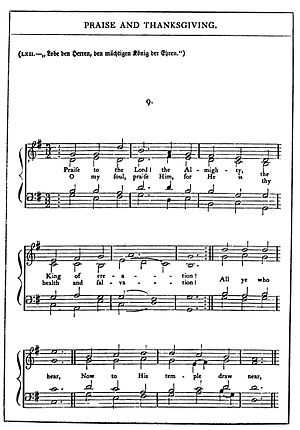Praise to the Lord, the Almighty

"Praise to the Lord, the Almighty" is a hymn based on Joachim Neander 's German chorale Lobe den Herren, den mächtigen König der Ehren, published in 1680.[2] John Julian in his A Dictionary of Hymnology calls the German original "a magnificent hymn of praise to God, perhaps the finest creation of its author, and of the first rank in its class."[3]
The melody used by Neander, first published in 1665, exists in many versions and is probably based on a folk tune.[4] The text paraphrases Psalm 103 and Psalm 150.[2] Catherine Winkworth published her English translation of Neander's hymn in 1863.[5]
Early history
The common name given to this melody is "Lobe den Herren".[6] Several variants were published with various secular texts between 1665 to 1680, when Joachim Neander published his German hymn Lobe den Herren, den mächtigen König der Ehren, using its meter.[4]
It was the favorite hymn of King Frederick William III of Prussia, who first heard it in 1800.[3][5]
Musical settings
Johann Sebastian Bach used the chorale as the base for his chorale cantata Lobe den Herren, den mächtigen König der Ehren, BWV 137, in 1724. Although only the text of the outer stanzas was kept completely, he referred to the unusual melody in bar form with a Stollen of five measures and a climax at the beginning of the Abgesang in all movements but one.[7] John Eliot Gardiner assumes, looking at the festive instrumentation and the general content of praise and thanksgiving, that the cantata was also performed that year to celebrate Ratswahl, the inauguration of the Leipzig city council.[8] In 1729 Bach concluded his wedding cantata Herr Gott, Beherrscher aller Dinge, BWV 120a, with the final movement of the chorale cantata, transposed to D major.[7] Bach transformed the central movement of his cantata to one of his Schübler Chorales.[9]
Several composers wrote organ preludes on the chorale, including Johann Gottfried Walther, Johann Philipp Kirnberger, and Max Reger as both op. 24 and part of his collection op. 135a. Johann Nepomuk David composed a Toccata on the tune.
The German choral composer Hugo Distler produced a popular arrangement of the hymn for a capella chorus, as part of his Drei kleine Choralmotetten.
Text
In the Neander original, first the singer calls himself (my beloved soul) to praise God, then calls for a larger group to join the praise with musical instruments as well as song:
| “ | Lobe den Herren, den mächtigen König der Ehren! Meine geliebete Seele, das ist mein Begehren. Kommet zu Hauf! Psalter und Harfe, wacht auf! Lasset den Lobgesang hören! |
” |
John Julian 's A Dictionary of Hymnology lists more than ten English translations of "Lobe den Herren" printed in various nineteenth century hymnals.[3]
The first verse of the Winkworth translation is
| “ | Praise to the Lord, the Almighty, the King of Creation O my soul, praise him, for he is thy health and salvation! All ye who hear, Now to his temple draw near, Join me in glad adoration! |
” |
Lionel Adey uses Winkworth's translation as an example of translators' reshaping a text to their own era's tastes, noting that she discards the German Renaissance flavor of psaltery and harp to introduce a mention of "health" more typical of nineteenth-century Christianity. Although he praises other translations by Winkworth, and describes this one as a twentieth-century "classic," he critiques her changes to the sense of Neander's text as an example of "muscular Christianity tinged with Philistinism."[11]
References
- ↑ Editors: Sir William Sterndale Bennett, Otto Goldschmidt; Translator: Catherine Winkworth (1865). "The Chorale Book for England". Longman, Green, Longman, Roberts, and Green
- ↑ 2.0 2.1 John Braisted Carman (1994). Majesty and meekness. p. 167. ISBN 978-0-8028-0693-2
- ↑ 3.0 3.1 3.2 Julian, John (1892). A Dictionary of Hymnology. . Scribner's Sons. p. 683.
- ↑ 4.0 4.1 Glover, Raymond (1990). The Hymnal 1982 Companion, Volume 3. Church Publishing, Inc. pp. 738–740. ISBN 978-0-89869-143-6.
- ↑ 5.0 5.1 Watson, John Richard; Timothy Dudley-Smith (2002). An annotated anthology of hymns. Oxford University Press. pp. 79–81. ISBN 0-19-826973-0.
- ↑ The Harvard University Hymn Book. Harvard University. 1964-01-01. p. 290. ISBN 978-0-674-38000-4.
- ↑ 7.0 7.1 Julius Mincham (2010). "Chapter 3 BWV 137 Lobe den Herren, den mächtigen König der Ehren". jsbachcantatas.com. Retrieved 9 September 2011.
- ↑ John Eliot Gardiner (2007). "Cantatas for the Twelfth Sunday after Trinity / Jakobskirche, Köthen" (PDF). monteverdiproductions.co.uk. p. 4. Retrieved 7 September 2011.
- ↑ George B. Stauffer (2011). "Bach: Clavierübung III & Schübler Chorales/Lippincott". gothic-catalog.com. Retrieved 20 September 2011.
- ↑ Literal English translation: "Praise the Lord, the Almighty King of glory!/My beloved soul, that is my desire./Come in multitudes!/Psaltery and harp, wake up!/Let the song of praise be heard!
- ↑ Adey, Lionel (1986). Hymns and the Christian "myth". University of British Columbia Press. p. 161. ISBN 978-0-7748-0257-4.
| Wikimedia Commons has media related to Lobe den Herren, den mächtigen König der Ehren. |